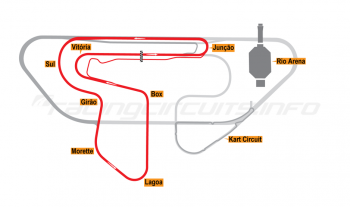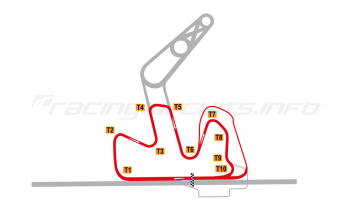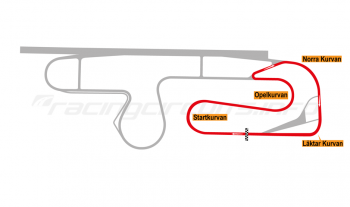Bristol Motor Speedway
Circuit Overview
The term 'theatre of speed' is probably the most apt way to describe Bristol Motor Speedway, the half-mile oval which has been among the most popular NASCAR tracks since its inception in 1961. With giant grandstands towering high above the high-banked track on all sides, Bristol is probably the closest modern equivalent to a Roman gladiatorial arena.
Billed as the "World's Fastest Half-Mile", Bristol is a fan-favourite if for no other reason than it is different. The concrete track, twin pit lanes and furious nature of the racing makes it one of the biggest spectacles on the NASCAR circuit.
Under Speedway Motorsports ownership the track has continued to innovate, with the entire circuit converted to dirt in 2001 and 2002 for the World of Outlaws and again from 2021 onwards for the NASCAR Cup series spring race.
Circuit History
The circuit was the brainchild of Carl Moore, who built the track along with Larry Carrier and R.G. Pope. Carrier and Moore were inspired to bring stock car racing to north-east Tennessee after a visit to the newly-constructed Charlotte Motor Speedway in North Carolina in 1960. Initially, a plot of land in Piney Flats, seven miles south of the current location, was proposed but the idea met local opposition and the pair began to look elsewhere.
A dairy farm less than 10 miles to the north on Highway 11-E in Bristol proved the best alternative, and 100 acres of land was bought for the sum of $600,000. Rather than building a replica of Charlotte, the pair opted for a half-mile oval, measuring 60 feet wide on the straights and 75 feet wide in the turns, which were banked at 22 degrees. Design was very much a back-of-the-envelope affair, but work began on what was then called Bristol International Speedway in 1960 and was completed in around 12 months.
The newly completed facility boasted parking for 12,000 cars and seating for 18,000. The short length necessitated one of Bristol's signature features; two pit lanes were required to cater for all of the starters – one of the frontstretch and another on the backstretch.
After hosting a series of weekly races in early part of 1961, the first NASCAR event was held on July 30, 1961. Country music star Brenda Lee, who was 17 at the time, sang the national anthem and the field of 42 cars got underway. Jack Smith of Spartanburg, S.C. entered the record books as the first NASCAR winner. Unusually, he wasn't actually in the driver's seat when the car took the chequered flag – after 290 laps the extreme heat had taken its toll and blistered Smith's feat, so he turned over driving duties to Johnny Allen, of Atlanta, who finished the race as a relief driver. It was a scene that was commonplace in the early years of racing at Bristol.
For the next eight years, from the summer of 1961 through the middle of 1969, Bristol established itself as a place where victories were hard-earned and it soon became among the most prestigious races on the calendar. Four of the 11 winners in those early years, Bobby Allison, Junior Johnson, David Pearson and Richard Petty, now have stands named after them at the facility.
Big banking arrives and the gladiator's arena is born
After Allison's Southeastern 500 win in the spring of 1969, track owners Carrier and Moore decided to make a change. The banking of the turns was dramatically increased to 36 degrees and the whole track dug up and resurfaced in time for the the July 20 Volunteer 500.
The new banking was the steepest of any track in the country and increased the lap distance, moving it from a half-mile or 2,640 feet to a distance of around .533 miles or 2,814 feet. Speeds dramatically increased as well, with Cale Yarborough shattering the record by nearly 15 miles per hour with a pole-winning speed of 103.432 in the July race. David Pearson won the first race on the new layout, leading 317 of the 500 laps and beating Bobby Isaac to the line by three laps.
The new configuration further promoted the paint-swopping, caution-filled races that became a trademark at Bristol; with so many cars in such a small space, contact is almost inevitable. Until the advent of the 'lucky dog' rules in 2004, Bristol was one of the few venues where it was still possible to race to victory from multiple laps down. Of course, the short lap length also cuts the other way; any unscheduled pit stop under green flag conditions will result in the driver going two or more laps down.
The speedway was sold after the 1976 season to Lanny Hester and Gary Baker and in the spring of 1978 the track name was changed to Bristol International Raceway. In August of that year, the first night race was held on the oval, one that would become one of the most popular and highly anticipated events on the NASCAR Sprint Cup Series calendar.
Despite this, making profits at the venue proved a challenge. On April 1, 1982 Lanny Hester sold his half of the speedway to Warner Hodgdon who in turn completed a 100 percent purchase of Bristol Motor Speedway, as well as Nashville Speedway, in a buy-sell agreement with Baker in July 1983. Hodgdon named Larry Carrier as the track's general manager but in January 1985, Hodgdon filed for bankruptcy as a result of many of his other businesses hitting hard times. Afterwards, Larry Carrier formally took possession of the speedway and covered all outstanding debts.
Under Carrier's second period of ownership, fan seating areas were dramatically increased, to the point that by the 1990s capacity was approaching 60,000. Other investments continued and, in 1992, the decision was taken to repave the facility, this time using concrete rather than asphalt. The new surface was in reaction to the near constant patching that had to be carried out to the old surface thanks to the increased power and traction of the modern stock cars.
Also new was the paved infield, which for the first time allowed teams to park their haulers within the circuit confines. Previously, team transporters were parked in a lot outside of the track. During racing periods, crews and participants were landlocked by the track, and thus, unable to return to the transporters for spare parts, repairs, or rest. Even with the paving, space is still very confined and requires the truck drivers to take part in an orchestrated parking exercise that takes several hours – and plenty of driving skill – to complete.
Bruton Smith takes the helm
On January 22, 1996, Larry Carrier sold the speedway to Bruton Smith's Speedway Motorsports, Inc. (SMI), at a purchase price of $26 million. At the time of the sale, the facility seated 71,000. On May 28 of that same year, the track's name was officially changed to Bristol Motor Speedway. By August, 15,000 seats had been added bringing the seating capacity to 86,000.
BMS continued to grow and by April of 1997 was the largest sports arena in Tennessee and one of the largest in the country, seating 118,000. The speedway also boasted 22 new skyboxes. Further increases in capacity came with the completion of the Kulwicki Terrace and Kulwicki Tower in 2000 (up to 148,000), while further investments by SMI included the addition of a long-awaited pedestrian tunnel in 2002. This allowed access into and out of the infield during on-track activity for the first time.
Perhaps the most unusual decision during this period was the temporary conversion of the circuit to a dirt surface to host the World of Outlaws series in both 2000 and 2001. More than 14,000 cubic yards of dirt were required to cover the concrete track surface, completing a transformation which only served to reinforce the gladiatorial feel of the arena. The events proved popular, even if the income perhaps didn't match the expenditure.
On Monday, August, 26, 2002, work began on an ambitious project that would see the entire backstretch, including the Speedway's remaining concrete seating, demolished in favour of a new grandstand that would increase the track's seating capacity to an estimated 155,000. The backstretch now includes three levels of seating and features 52 luxury skybox suites. A further 35 were added in 2005.
Track resurfacing was completed in 2007 and resulted in a revision to the advertised banking figures, the new turns now being rated with variable banking at between 24 to 30 degrees. The original 36 degree figure had long been a source of contention; Ryan Newman in particular disputed the figure, stating his crew has measured it at only 26 degrees, while ESPN often claimed the turns were banked at 35 degrees during television telecast of events at the track during the 1980s.
The new banking changed the nature of racing at Bristol and not necessarily for the better according to the fans. In March 2012, Bruton Smith launched a 10-day consultation, announcing at its conclusion a decision to reduce the banking on the upper third of the circuit to match that of the middle section, eliminating the third groove as a viable option and creating tighter racing. Reconstruction work took seven weeks to complete, with Denny Hamlin taking the first victory on the new racing surface in August 2012.
Innovations continue as Bristol goes back to dirt
The innovations continued at Bristol, with the scoring pylon replaced in 2016 with a large 4-sided display hung by cables over the centre of the infield, similar to those seen at football and basketball stadia. Named "Colossus TV", the track claims it is the largest outdoor-hung display of its kind in the world, with each screen measuring 30 feet (9.1 m) by 63 feet (19 m).
In 2021, the circuit launched an ambitious programme to temporarily convert the racing surface to dirt once again, this time in order to host NASCAR's first foray onto a loose surface since the 1970s. It would see the temporary surface laid down over several months, with varying thicknesses required to even out and lessen the banking.
"We couldn't just put a layer of dirt down right on top of the concrete because that would be way too steep for the dirt races and would create way too much speed," explained Steve Swift, senior vice president of operations and development for Speedway Motorsports, as construction got under way. "We've shallowed it up and we will be at 19 degrees when it is all said and done. The thickest fills will be 9ft and 10ft and our smallest fill will be a foot."
Learning from the experience of 20 years before, engineers carried out a series of experiments to determine the best way to lay down the temporary surface. The final solution included a base layer of sawdust from mainly oak and poplar trees, covered with a stockpile of earth the circuit had kept from the 2000/1 events. Further earth from the Gentry's parking and camping site next to the track formed another layer, topped by lime treated clay and a top surface of Tennessee clay.
The gargantuan effort required some 2,300 truck loads of materials being moved onto site, with the effort certainly generating the headline. The Food City Dirt Race was the first dirt race for NASCAR's premier category since 1970, with a the bill also including the Pinty's Truck Race on Dirt.
Also learning from past experience, the dirt surface will be used for multiple events before being removed to maximise the return on expenditure. The track hosted the Bristol Dirt Nationals on March 15-20 ahead of the Cup race, while the World of Outlaws returned for the Bristol Bash on April 8-10 and the World of Outlaws Bristol Throwdown on April 22-24.
The experiment proved a success, despite some challenging weather conditions, which saw the washout of both the Saturday and Sunday races, eventually held on the Monday. Joey Logano navigated his Penske Racing Ford Mustang to Victory Lane to become the first modern era dirt race winner, earning a trophy and a gladiator's sword for his troubles!
For 2022, the Food City Dirt Race will move to the evening and be held under the lights as a night race, with the date moved several weeks back in the hope of attracting better weather.
Jump onboard
Circuit info
- Bristol Motor Speedway, 151 Speedway Blvd., Bristol, Tennessee 37620, USA
- +1 423 989 6933
- Email the circuit
- Official website
Rate This Circuit
Votes: 5891
Plan a visit
Get your race tickets!
Brought to you with: 
We've teamed up with Motorsports Tickets to bring you the best deals for Formula One, MotoGP, Le Mans and more.












